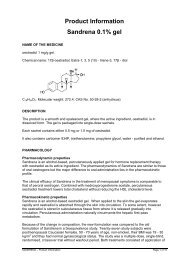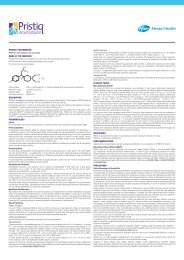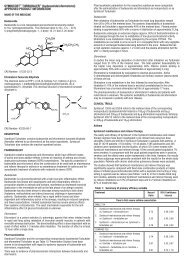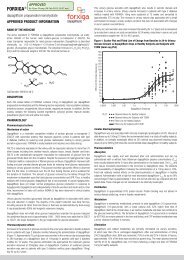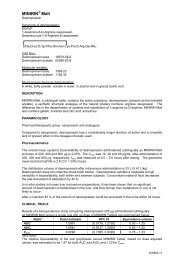You also want an ePaper? Increase the reach of your titles
YUMPU automatically turns print PDFs into web optimized ePapers that Google loves.
maximum recommended dose. In rats receiving the maternotoxic dose of 45 mg/kg/dayduring organogenesis, there was increased preimplantation loss and resorptions, andreduced fetal weight.Oral administration of duloxetine to female rats prior to and throughout mating, gestationand lactation at doses of 30-45 mg/kg/day (2-3 times the maximum recommended humandose on a mg/m 2 basis) elicited maternal toxicity and reduced live birth indices, birthweight, and postnatal survival and growth of offspring, and altered some indices ofoffspring behaviour.Neonates exposed to serotonergic agents late in the third trimester have beenuncommonly reported to have clinical findings of respiratory distress, cyanosis, apnoea,seizures, temperature instability, feeding difficulty, vomiting, hypoglycaemia, hypotonia,hypertonia, hyperreflexia, tremor, jitteriness, irritability and constant crying. Such eventscan arise immediately upon delivery and are usually transient. The majority of cases haveoccurred either at birth or within a few days of birth. These features could be consistentwith either a direct effect of SSRIs and SNRIs or, possibly, a drug discontinuationsyndrome. When treating a pregnant woman with duloxetine during the third trimester,the physician should carefully consider the potential risks and benefits of treatment.The safety of duloxetine in human pregnancy has not been established and becauseanimal reproduction studies are not always predictive of human response, this drugshould be used during pregnancy only if the potential benefit justifies the potential risk.Use in LactationDuloxetine is excreted into the milk of lactating women. The estimated infant doseranges from approximately 0.1% to 0.3% of the maternal dose, normalised by bodyweight. Oral administration of duloxetine to female rats prior to and throughout mating,gestation and lactation was associated with maternal toxicity and adverse effects (see Usein Pregnancy). Administration of CYMBALTA to nursing mothers is not recommended.Labour and DeliveryThe effect of duloxetine on labour and delivery in humans is unknown.Interactions with Other DrugsDuloxetine is a SNRI with its primary effect on the CNS. Caution should be used when itis administered in combination with other centrally acting drugs and substances,especially those with a similar mechanism of action, including alcohol. Concurrent usewith other drugs with serotonergic activity (eg SNRIs, SSRIs, triptans or tramadol) mayresult in serotonin syndrome (see PRECAUTIONS).Although duloxetine does not increase the impairment of mental and motor skills causedby alcohol, use of CYMBALTA with substantial alcohol consumption may be associatedwith severe liver injury. Isolated cases of liver failure, including fatal cases, have beenreported (see PRECAUTIONS – Hepatotoxicity). CYMBALTA should only be used inexceptional circumstances with extreme caution in patients who consume substantialCymbalta PI Nov 2012 v8.0 18



